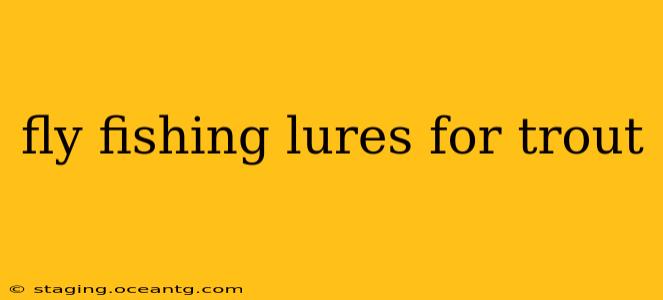Fly fishing for trout is a rewarding experience, demanding skill, patience, and the right equipment. Choosing the appropriate lure is crucial for success, as different flies mimic different insects and attract various trout species in diverse conditions. This guide explores the best fly fishing lures for trout, covering various types and when to use them. We'll delve into the nuances of fly selection, ensuring you're well-equipped to land your next trophy.
What are the best fly fishing lures for trout?
This isn't a simple question with a simple answer! The "best" fly fishing lure for trout depends heavily on several factors: the time of year, the specific type of trout you're targeting (rainbow, brown, brook, etc.), the water conditions (clear, murky, fast-flowing, still), and the insects currently hatching in the river or lake. However, some consistently effective patterns stand out.
Dry Flies: These imitate insects that float on the water's surface. Popular choices include:
- Adams: A classic all-around dry fly, effective in a wide range of situations. Its simple design mimics many mayflies and caddisflies.
- Royal Wulff: A flashy, attractive dry fly that works well in bright conditions or when trout are feeding aggressively.
- Elk Hair Caddis: A versatile dry fly that effectively imitates caddisflies, crucial during their emergence period.
- Stimulator: A larger dry fly that attracts attention and is great for bigger trout or when other flies aren't working.
Nymphs: These imitate aquatic insects in their nymph stage (before they become adults). Effective nymphs include:
- Prince Nymph: A classic nymph that mimics various aquatic insects, working well in various conditions.
- Pheasant Tail Nymph: A simple yet effective nymph, known for its subtle movement and lifelike appearance.
- Copper John: A brightly colored nymph that's highly visible in murky water or fast-flowing rivers.
- Zebra Midge: Small, effective nymphs ideal for imitating midges, a staple food source for many trout.
Wet Flies: These flies are designed to be fished submerged, mimicking insects drifting in the water column. Examples are:
- Bibio: A traditional wet fly that is effective in many conditions.
- Woolly Bugger: A versatile wet fly available in many colors and weights, imitates various insects and small baitfish.
- Adams Wet Fly: A submerged version of the popular Adams dry fly.
What type of fly should I use for trout fishing?
The type of fly you should use will depend heavily on the specific situation. Consider these factors:
-
Season: In spring, mayflies are common, so mayfly imitations are great. In summer, caddisflies and stoneflies are often prevalent. Autumn brings different hatches, requiring specific fly patterns. Winter often involves using smaller nymphs or midges.
-
Water Clarity: Clear water requires subtle flies that won't scare the trout. Murky water allows for brighter, more visible flies.
-
Water Flow: Fast-flowing rivers may benefit from heavier nymphs that stay in the current, while slower-moving water might allow for a wider selection of flies.
What color flies are best for catching trout?
Trout are opportunistic feeders and color preference can fluctuate based on many factors like light, water clarity, and available food sources. However, some general guidelines are useful:
- Olive and brown: These are generally effective colors as they mimic many natural insects.
- Black and gray: These work well in darker conditions or when imitating certain insects.
- Cream and tan: These can be effective in mimicking some aquatic insects.
- Bright colors: Sometimes, a more vibrant color can attract aggressive trout, particularly in murky water.
What size flies are best for trout fishing?
Fly size depends on several factors, including the size of the trout you're targeting and the size of the insects they're feeding on. Smaller flies (size 16-22) are often best for selective trout in clear water, while larger flies (size 6-12) can work in faster water or when trout are less discerning.
How do I choose the right fly for trout fishing?
Matching the hatch—selecting a fly that closely imitates the insects currently hatching—is a cornerstone of successful fly fishing. Observing the water for rising trout and identifying the insects they are feeding on is crucial. Local fly shops can also offer valuable advice on the current hatches in your area. Experimentation is also key; try different flies until you find what works best in a given situation.
Conclusion
Selecting the right fly fishing lure for trout is a critical aspect of successful fly fishing. By considering factors such as the time of year, water conditions, and available food sources, and understanding the different types of flies available, you can significantly improve your chances of landing a trophy trout. Remember to observe, adapt, and experiment to find what works best for you in your chosen fishing environment.
